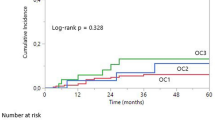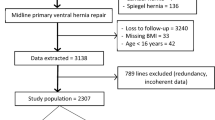Abstract
Purpose
Obesity is a risk factor for developing abdominal wall hernias and is associated with major postoperative complications, such as surgical site infection, delayed wound healing and recurrent hernia. Therefore, treating incisional hernia in this patient subgroup is a challenge.
Methods
We conducted a comparative, prospective study on patients who underwent primary ventral hernia surgery or incisional hernia surgery through the extended totally extraperitoneal pathway, with body mass indices (BMIs) ≤ 30 (no obesity) and BMI > 30 (with obesity). We collected demographic data, preoperative and intraoperative variables, complication and recurrence rate, hospital stay and follow-up as postoperative data.
Results
From May 2018 to December 2020, 74 patients underwent this surgery, 38 patients without obesity and 36 with obesity. The median area of the hernia defect measured by CT was 57 cm2 and 93 cm2 in patients without and with obesity, respectively (p = 0.012). The median follow-up was 16 months. One patient without obesity experienced some postoperative complication compared with four patients with obesity (p > 0.05). No patient without obesity had recurrent hernia compared with two patients with obesity (p > 0.05).
Conclusions
There were statistically significant differences between patients with and without obesity in the size of the hernia defect. However, there were no significant differences in terms of complications, hospital stay, postoperative pain or relapses. Therefore, the minimally invasive completely extraperitoneal approach for patients with obesity appears to be a safe procedure despite our study limitations. Studies with longer follow-ups and a greater number of patients are needed.
Similar content being viewed by others

Code availability
Statistical analysis was performed.
References
Birgisson G, Park AE, Mastrangelo MJ Jr, Witzke DB, Chu UB (2001) Obesity and laparoscopic repair of ventral hernias. Surg Endosc 15(12):1419–1422
Danzig MR, Stey AM, Yin SS, Qiu S, Divino CM (2016) Patient profiles and outcomes following repair of irreducible and reducible Ventral Wall Hernias. Hernia 20(2):239–247
Goodenough CJ, Ko TC, Kao LS, Nguyen MT, Holihan JL, Alawadi Z et al (2015) Development and validation of a risk stratification score for ventral incisional hernia after abdominal surgery: hernia expectation rates in intra-abdominal surgery (the HERNIA Project). J Am Coll Surg 220(4):405–413
Owei L, Swendiman RA, Kelz RR, Dempsey DT, Dumon KR (2017) Impact of body mass index on open ventral hernia repair: a retrospective review. Surgery 162(6):1320–1329
Liang MK, Bernardi K, Holihan JL, Cherla DV, Escamilla R, Lew DF et al (2018) Modifying risks in ventral hernia patients with prehabilitation: a randomized controlled trial. Ann Surg 268(4):674–680
Froylich D, Segal M, Weinstein A, Hatib K, Shiloni E, Hazzan D (2016) Laparoscopic versus open ventral hernia repair in obese patients: a long-term follow-up. Surg Endosc 30(2):670–675
Tsereteli Z, Pryor BA, Heniford BT, Park A, Voeller G, Ramshaw BJ (2008) Laparoscopic ventral hernia repair (LVHR) in morbidly obese patients. Hernia 12(3):233–238
LeBlanc KA, Booth WV (1993) Laparoscopic repair of incisional abdominal hernias using expanded polytetrafluoroethylene: preliminary findings. Surg Laparosc Endosc 3(1):39–41
Shabanzadeh DM, Sørensen LT (2012) Laparoscopic surgery compared with open surgery decreases surgical site infection in obese patients: a systematic review and meta-analysis. Ann Surg 256(6):934–945
Heniford BT, Park A, Ramshaw BJ et al (2003) Laparoscopic repair of ventral hernias: nine years’ experience with 850 consecutive hernias. Ann Surg 238(3):391–399
Mitura K, Skolimowska-Rzewuska M, Garnysz K (2017) Outcomes of bridging versus mesh augmentation in laparoscopic repair of small and medium midline ventral hernias. Surg Endosc 31(1):382–388
Daes J (2012) The enhanced view-totally extraperitoneal technique for repair of inguinal hernia. Surg Endosc 26(4):1187–1189
Belyansky I, Daes J, Radu V, Balasubramanian R, Zahiri H, Weltz A et al (2018) A novel approach using the enhanced-view totally extraperitoneal (eTEP) technique for laparoscopic retromuscular hernia repair. Surg Endosc 32(3):1525–1532
Baig SJ, Priya P (2019) Extended totally extraperitoneal repair (eTEP) for ventral hernias: short-term results from a single centre. J Minim Access Surg 15(3):198–203
Radu VG, Lica M (2019) The endoscopic retromuscular repair of ventral hernia: the eTEP technique and early results. Hernia 23(5):945–955
Salido Fernandez S, Fraile Vilarrasa M, Osorio Silla I, Georgiev Hristov T, de Oriol JB et al (2020) Extended totally extraperitoneal (eTEP) approach for ventral hernia repair: initial results. Cir Esp 98(5):260–266
Addo A, Lu R, Broda A, George P, Huerta N, Park A, Zahiri HR, Belyansky I (2021) Impact of body mass index (BMI) on perioperative outcomes following minimally invasive retromuscular abdominal wall reconstruction: a comparative analysis. Surg Endosc 35(10):5796–5802
Muysoms FE, Miserez M, Berrevoet F, Campanelli G, Champault GG, Chelala E et al (2009) Classification of primary and incisional abdominal wall hernias. Hernia 13(4):404–414
Evans KK, Chim H, Patel KM, Salgado CJ, Mardini S (2012) Survey on ventral hernias: surgeon indications, contraindications and management of large ventral hernias. Am Surg 78(4):388–397
Liang MK, Holihan JL, Itani K, Alawadi ZM, Gonzalez JR, Askenasy EP et al (2017) Ventral hernia management: expert consensus guided by systematic review. Ann Surg 265(1):80–89
Breuing K, Butler C, Ferzoco S, Franz M, Hultman C, Kilbridge JF et al (2010) Incisional ventral hernias: review of the literature and recommendations regarding the grading and technique of repair The Ventral Hernia. Surgery 148(3):544–558
Sajid M, Bokhari S, Mallick A, Cheek E, Baig M (2009) Laparoscopic versus open repair of incisional/ventral hernia: a metaanalysis. Am J Surg 197:64–72
Regner JL, Mrdutt MM, Muñoz-Maldonado Y (2015) Tailoring surgical approach for elective ventral hernia repair based on obesity and National Surgical Quality Improvement Program outcomes. Am J Surg 210(6):1024–1030
Papageorge CM, Funk LM, Poulose BK et al (2017) Primary fascial closure during laparoscopic ventral hernia repair does not reduce 30-day wound complications. Surg Endosc 149(5 Suppl):e3-7
Franklin ME, Gonzalez JJ, Glass JL et al (2004) Laparoscopic ventral and incisional hernia repair: an 11-year experience. Hernia 8(1):23–27
Chelala E, Baraké H, Estievenart J et al (2016) Long-term outcomes of 1326 laparoscopic incisional and ventral hernia repair with the routine suturing concept: a single institution experience. Hernia 20(1):101–110
Jenkins ED, Yom V, Melman L, Brunt LM, Eagon JC, Frisella MM, Matthews BD (2010) Prospective evaluation of adhesion characteristics to intraperitoneal mesh and adhesiolysis-related complications during laparoscopic re-exploration after prior ventral hernia repair. Surg Endosc 24(12):3002–3007
Warren Jeremy A, Love M (2018) Incisional hernia repair. Minimally invasive approaches. Surg Clin N Am 98:537–559
Colavita P, Tsirline MD, Belyansky V, Walters I, Lincourt A, Sin A, Heniford B (2012) Prospective, long-term comparison of quality of life in laparoscopic versus open ventral hernia repair. Ann Surg 256(50):714–723
Köckerling F, Simon T, Adolf D, Köckerling D, Mayer F, Reinpold W, Weyhe D, Bittner R (2019) Laparoscopic IPOM versus open sublay technique for elective incisional hernia repair: a registry-based, propensity score-matched comparison of 9907 patients. Surg Endosc 33(10):3361–3369
Kumar N, Palanisamy NV, Parthasarathi R, Sabnis SC, Nayak SK, Palanivelu C (2021) A comparative prospective study of short-term outcomes of extended view totally extraperitoneal (e-TEP) repair versus laparoscopic intraperitoneal on lay mesh (IPOM) plus repair for ventral hernia. Surg Endosc 35(9):5072–5077
Tulloh B, de Beaux A (2016) Defects and donuts: the importance of the mesh: defect area ratio. Hernia 20(6):893–895
Hauters P, Desmet J, Gherardi D, Dewaele S, Polivache H, Malvaux P (2017) Assessment of predictive factors for recurrence in laparoscopic ventral hernia repair using a bridging technique. Surg Endosc 31(9):3656–3663
Gokcal F, Morrison S, Kudsi OY (2020) Robotic ventral hernia repair in morbidly obese patients: perioperative and mid-term outcomes. Surg Endosc 34(8):3540–3549
Funding
The authors declare that they have no financial ties to disclose.
Author information
Authors and Affiliations
Corresponding author
Ethics declarations
Conflict of interest
The authors have no related conflicts of interest to declare.
Ethical approval
For this type of study, ethical approval is not required.
Human and animal rights
All procedures performed in this study involving human participants were in accordance with the 1964 Helsinki declaration and its later amendments or comparable ethical standards. This article does not contain any study with animals performed by any of the authors.
Informed consent
Informed consent was obtained from all individual participants of the study.
Additional information
Publisher's Note
Springer Nature remains neutral with regard to jurisdictional claims in published maps and institutional affiliations.
Rights and permissions
About this article
Cite this article
Sánchez García, C., Osorio, I., Bernar, J. et al. Body Mass Index impact on Extended Total Extraperitoneal Ventral Hernia Repair: a comparative study. Hernia 26, 1605–1610 (2022). https://doi.org/10.1007/s10029-022-02581-2
Received:
Accepted:
Published:
Issue Date:
DOI: https://doi.org/10.1007/s10029-022-02581-2



